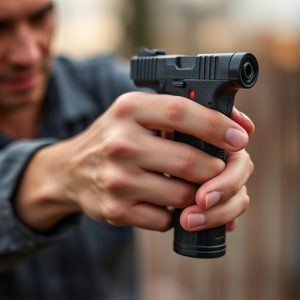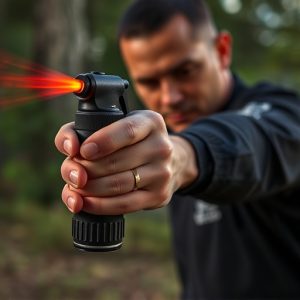Pepper Spray & Wind Direction: Effective Riot Control Strategies
Pepper spray, a powerful riot control tool, relies on capsaicin to temporarily disable targets. For…….
Pepper spray, a powerful riot control tool, relies on capsaicin to temporarily disable targets. For optimal deployment, understanding wind direction is crucial; aiming into the wind ensures maximum effectiveness and prevents spray from blowing back towards users or bystanders. Effective use strategies include assessing wind speed and direction, wearing protective gear, and training personnel in accurate spraying techniques, minimizing risks while maximizing control during high-intensity situations. Prioritizing safety, strategic deployment, and tailored pepper spray formulations further reduce potential harm to civilians and infrastructure.
In the realm of riot control, understanding pepper spray—its science, deployment, and safety considerations—is paramount. This potent tool, often relied upon in high-pressure situations, creates an inflammatory effect that disrupts and disperses crowds. This article delves into the mechanics of pepper spray, offering insights on effective use, bystander safety, and crucial wind direction tips for optimal control while minimizing harm. “Pepper Spray Wind Direction Tips” are explored extensively, providing a comprehensive guide for law enforcement and security professionals.
- Understanding Pepper Spray: A Powerful Tool for Riot Control
- The Science Behind Pepper Spray's Inflammatory Effect
- Effective Use: Strategies and Techniques for Optimal Deployment
- Considerations for Safety and Minimizing Impact on bystanders
- Wind Direction Tips: Maximizing Control, Minimizing Harm
Understanding Pepper Spray: A Powerful Tool for Riot Control
Pepper spray, a potent and fast-acting irritant, has become an indispensable tool in riot control and crowd management worldwide. Its primary active ingredient, capsaicin, is extracted from chili peppers and triggers a burning sensation when it comes into contact with eyes, skin, and respiratory membranes. This powerful agent temporarily disables individuals, providing crucial time for law enforcement to restore order and ensure public safety during high-intensity situations.
When deploying pepper spray, understanding the wind direction is vital. Strategically aiming against the wind allows for maximum effectiveness as it prevents the spray from blowing back towards the users, ensuring safer handling. Pepper spray particles can travel significant distances, so operators must be mindful of their surroundings and potential impact on bystanders. Proper training and adherence to safety protocols are essential to minimize risks and maximize the tool’s efficiency in riot control scenarios.
The Science Behind Pepper Spray's Inflammatory Effect
Pepper spray, a common tool in riot control and law enforcement, creates its inflammatory effect through a unique chemical compound known as capsaicin. This substance is derived from chili peppers and is responsible for the burning sensation often associated with spicy foods. When pepper spray is deployed, the fine mist contains millions of tiny droplets that can reach the eyes, nose, and skin of individuals in their path.
The wind direction plays a pivotal role in determining the effectiveness of pepper spray. Strategically aiming the spray into the wind ensures maximum coverage and impact. Understanding wind patterns and utilizing them to your advantage can significantly enhance the ability to control crowds or disrupt riotous behavior. Tips for optimal usage include assessing wind speed and direction, ensuring proper protective gear, and training personnel on accurate spraying techniques to maximize pepper spray’s inflammatory effect.
Effective Use: Strategies and Techniques for Optimal Deployment
When employing inflammatory spray for riot control, understanding effective use strategies is paramount. One key aspect to optimize deployment is considering the wind direction. Utilizing pepper spray against the breeze ensures maximum coverage and minimises its impact on friendly forces. By positioning officers with backwind, the spray’s effects are directed away from them, reducing self-irritation and improving tactical effectiveness.
Additional techniques include aiming low to capture ground-level airflow, which can help contain and disperse the spray. Training personnel in proper application methods, such as deploying the spray in short bursts at close range, enhances control while minimizing potential harm to bystanders. These strategies, combined with awareness of wind patterns, enable law enforcement to use inflammatory sprays responsibly and efficiently during riot situations.
Considerations for Safety and Minimizing Impact on bystanders
When using inflammatory spray for riot control, safety is paramount. One crucial consideration is understanding the wind direction and utilizing it to minimize impact on bystanders. Pepper spray particles can travel considerable distances, so a strategic approach is essential. By gauging the wind, law enforcement officers can deploy the spray in a way that prevents it from reaching innocent citizens. Simple tips like spraying into the wind or towards the ground at an angle help contain the effects within the targeted area.
Additionally, choosing the right type of pepper spray for specific scenarios is vital. Some formulations are designed to reduce the risk of causing respiratory distress in bystanders, making them more suitable for crowded public spaces. Training officers on proper usage techniques and ensuring they follow protocols for decontamination after deployment further mitigate potential harm. These precautions not only protect bystanders but also maintain the integrity of law enforcement operations during high-pressure situations.
Wind Direction Tips: Maximizing Control, Minimizing Harm
When utilizing pepper spray for riot control, understanding wind direction becomes a strategic advantage, allowing law enforcement to maximize its effectiveness while minimizing potential harm to bystanders. The key lies in deploying the spray into the prevailing wind, ensuring it drifts away from civilian areas and towards the crowd’s path or retreat. By aligning with the wind, officers can create a barrier that slows down rioters’ progress without exposing innocent people to the irritant.
Conversely, when the wind blows against you, it’s crucial to choose non-spray methods or use protective gear. Pepper spray in the wrong direction might backfire, affecting your own forces and making it harder to control the situation. In such cases, tactical techniques that don’t rely on wind dynamics become more viable options for maintaining order without causing unnecessary discomfort or damage to nearby buildings and infrastructure.
Pepper spray, with its inflammatory properties, serves as a powerful tool in riot control, offering strategic advantages when deployed effectively. Understanding the science behind its action and considering safety measures, especially wind direction tips, is crucial for minimizing impact on bystanders while maximizing control during chaotic situations. By employing optimal deployment techniques, professionals can ensure public safety while managing crowds, making pepper spray a valuable asset in their arsenal.


